LOOKING BACKWARD, LOOKING FORWARD
Here’s a backward story and a forward story.
About plants, of course. And the plants are linked in that both of them are native to the Mediterranean region. But for centuries, both plants have been grown world-wide wherever winters are mild. And, with some special attention, by enthusiast (such as me), in gardens where winters are frigid.
Perhaps you’ve already guessed the two plants. If not, they are cardoon and fig. Let’s start with the backward story, which is the one about cardoon.

Cardoon & Fig
A Florific Season in the Offing (I Know It’s not a Word)
The end of the cardoon story begins with my memory of last summer’s very bold plant whose whorl of glaucous, spiny leaves rose three feet or more above ground level. 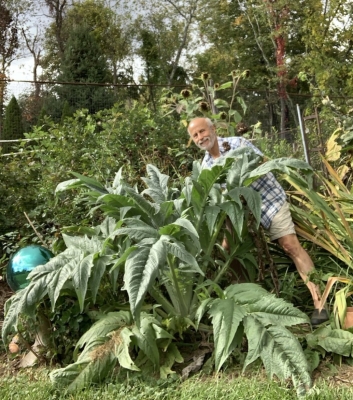 Bold as it was, the pièce de résistance for this plant was the flower stalk that pushed skyward well above that leafy whorl to be capped by a bottlebrush cluster of cerulean purplish flowers contrasted the blue of the sky.
Bold as it was, the pièce de résistance for this plant was the flower stalk that pushed skyward well above that leafy whorl to be capped by a bottlebrush cluster of cerulean purplish flowers contrasted the blue of the sky.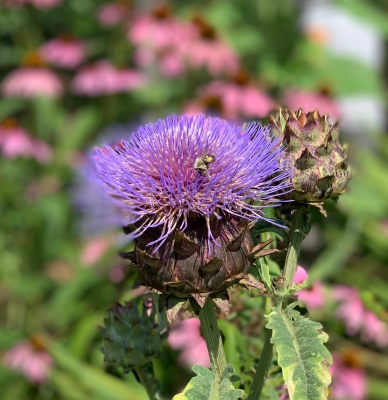
Right now, my cardoon plant is just beginning to show it’s muscle, which surprised me. I thought it would still be asleep, the leaves, which I had cut off but which would have anyway frozen in winter, are long gone but the roots, I thought, would still be awaiting spring warmth.
Not so; cardoon wasn’t waiting any longer. To make sure it survived winter, back in late December I had covered the whole plant with an upturned large, black plastic flower pot, then topped that and banked up the sides with wood chips.  A few days ago, I noticed some leaves attempting escape just beyond the pot’s upside down rim.
A few days ago, I noticed some leaves attempting escape just beyond the pot’s upside down rim.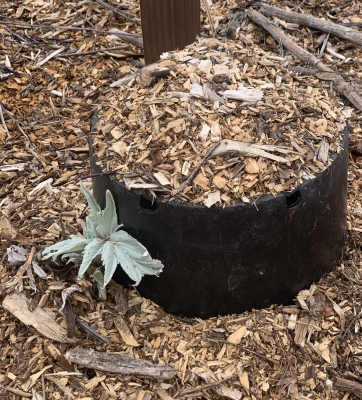 I pulled back the chips and removed the pot and, lo’ and behold, the whole plant was raring to grow, with a few leafy whorls already about a foot high.
I pulled back the chips and removed the pot and, lo’ and behold, the whole plant was raring to grow, with a few leafy whorls already about a foot high.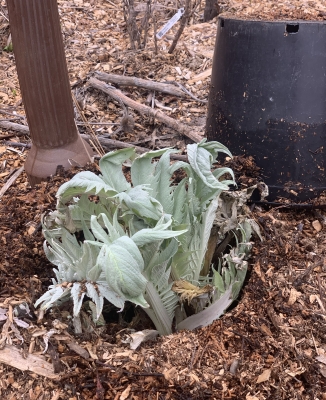
Those whorls are daughter plants that sprout near the base of the mother plant, the old whorl dying after flowering. I could dig out one or two of those whorls with some roots attached, and replant them elsewhere. But, as I wrote, cardoon is a bold plant, and one is enough for me. Digging up some whorls would prevent overcrowding, allowing the remaining whorl or whorls to grow larger.
My guess is that, with nothing more than a little mulch, cardoon roots would survive the Zone 5 winters here. Of course, the past two winters haven’t doled out the minus twenty degrees Fahrenheit temperatures they have in the past. At any rate, protecting the plant beneath an upturned pot is worthwhile because cardoon’s fleshy crown tends to rot if cold water or snow sits on it.
Besides putting on quite a show, cardoon is considered a delicacy to some people. Not me; I grow it only for show. The leaf stalks and the flower stalks are all part of Mediterranean cuisine. Cardoon is a dead ringer for artichoke, to which it is closely related, sometimes both plants are considered botanical varieties of the same species. The unopened flower buds do look just like small artichokes.
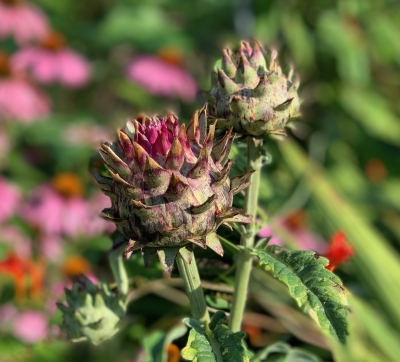
Cardoon flower bud
Unfortunately, artichokes are not nearly as cold hardy as cardoon. I grew them with the same winter treatment and they were stone-dead in spring.
A Fruitful (Outdoor) Fig Season?
Moving on to figs, which is a forward-looking story because I’m not sure what to expect from the two plants of this story. I grow lots of fig plants, all of which weather winter here fine by various methods which I detail in my book Growing Figs in Cold Climates. The past two winters, I’ve tried a new method that could prove in many ways easier to implement and suited to a broader range of cold-winter fig enthusiasts.
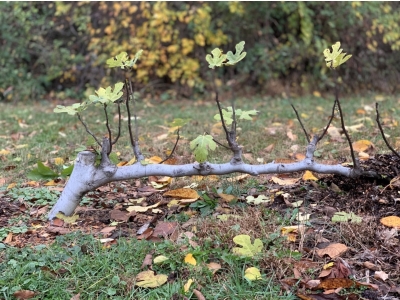
Weak growth first year of new method
To rehash some of what I mention in my book, figs are subtropical plants, with their dormant stems cold hardy into the ‘teens. Many varieties, including the two on which I’m trying out my method — Chicago Hardy and Bethlehem Black — bear fruit each year on new shoots that arise on older stems. Like cardoon, fig roots could survive winters here, perhaps helped along with a little mulch. But unprotected, the stems would die to the ground, which would leave no older stems off which new shoots could grow to ripen fruit.
With this new method, the plants are grown directly in the ground, outdoors. No need to bend the plant down to or below ground level and cover it with soil, leaves, or some insulating material, then disinter it the following late winter or early spring. Pruning and training are a slight variation of the espalier pruning I describe in my book for growing figs in a greenhouse or a hoop house.
What I did with one fig plant, a young one, was to plant it in the bottom of a shallow trench at a forty-five degree angle, then train one sturdy stem, with the help of a bamboo rod, horizontally at about ground level in the trench. The other plant was older so I instead cut the main stem to a low horizontal stem, training that stem parallel to and a few inches off the ground. In either case, I removed all other stems.
The stem of the plant growing just above ground level, and especially the stem of the plant growing at or slightly below ground level, should pick up some heat from the ground below. (If more cold protection was needed, the trench and the stem could be further below ground level.)
To capture and retain some of the ground heat through winter, I made small tents of one-by-two foot pieces of double wall polycarbonate greenhouse panels joined along their two-foot edges with gaffer’s tape. Placed end to end over each fig plant, the ends shuttered with triangular pieces of polycarbonate, the tents formed a cozy winter tunnel for the plants.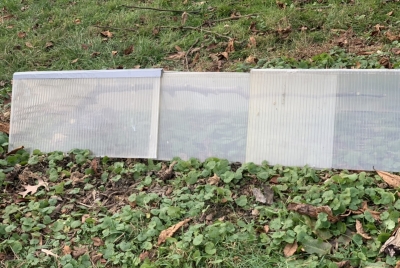

Note tunnel peeking through chips
That’s not enough cold protection for a potential minus twenty degree winter night, so I piled wood chips against and atop the tunnel.
Fast forward to today, two days before spring: I couldn’t help but try to peak beneath the chips. From what I could see, everything looked dormant but alive and undamaged by mice. I had planned to avoid mouse damage, which was extensive the first year, by spraying the plants with Bobbex animal repellant just before covering them in late December. By then, rodents would have already settled into a winter home — elsewhere.
I had planned to avoid mouse damage, which was extensive the first year, by spraying the plants with Bobbex animal repellant just before covering them in late December. By then, rodents would have already settled into a winter home — elsewhere.
Today I pulled back the chips to let the sun warm the mini-greenhouse.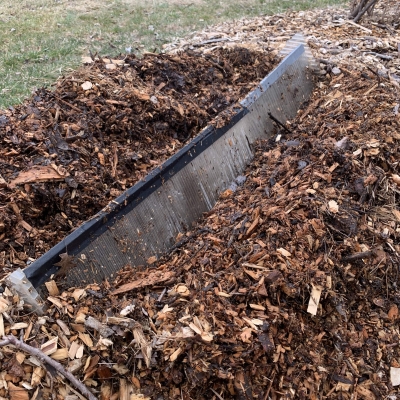
If all goes as planned, spring sunlight will coax buds to awaken, then expand into shoots that won’t outgrow the tunnel before I can remove it and let the figs face the great outdoors. I’ll remove any but well-spaced shoots that grow vertically from the horizontal stems, shoots which will yield ripe figs beginning near their origin and ripening progressively with the growing shoot.
If the method fails, I’ll tweak it for next year. No matter what, I’ll still have plenty of figs to eat from all my potted and greenhouse plants.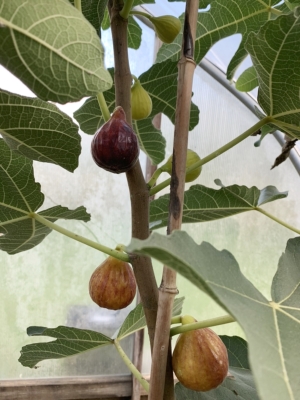

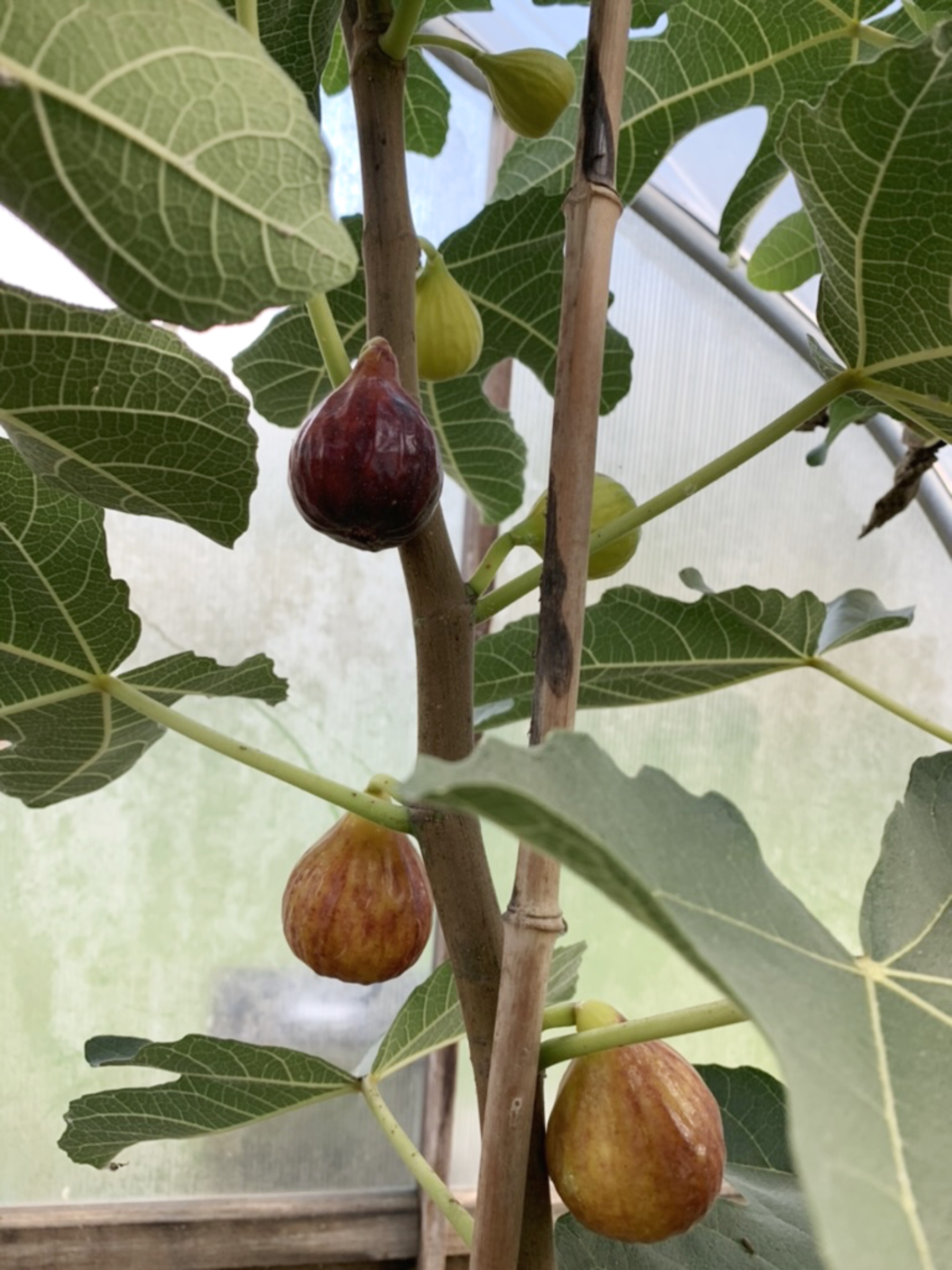
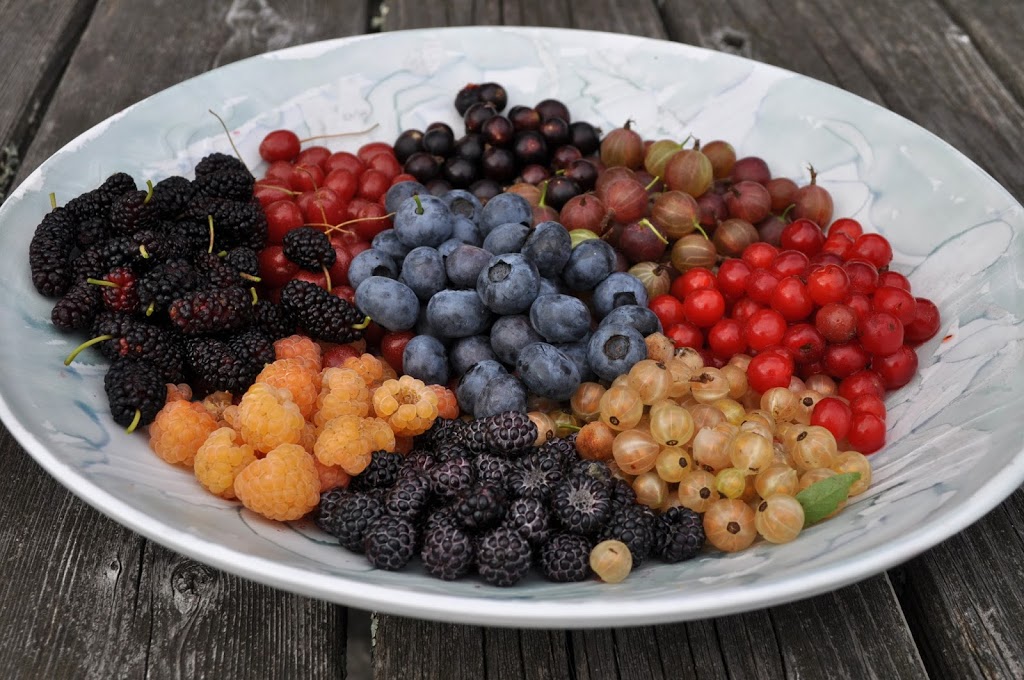

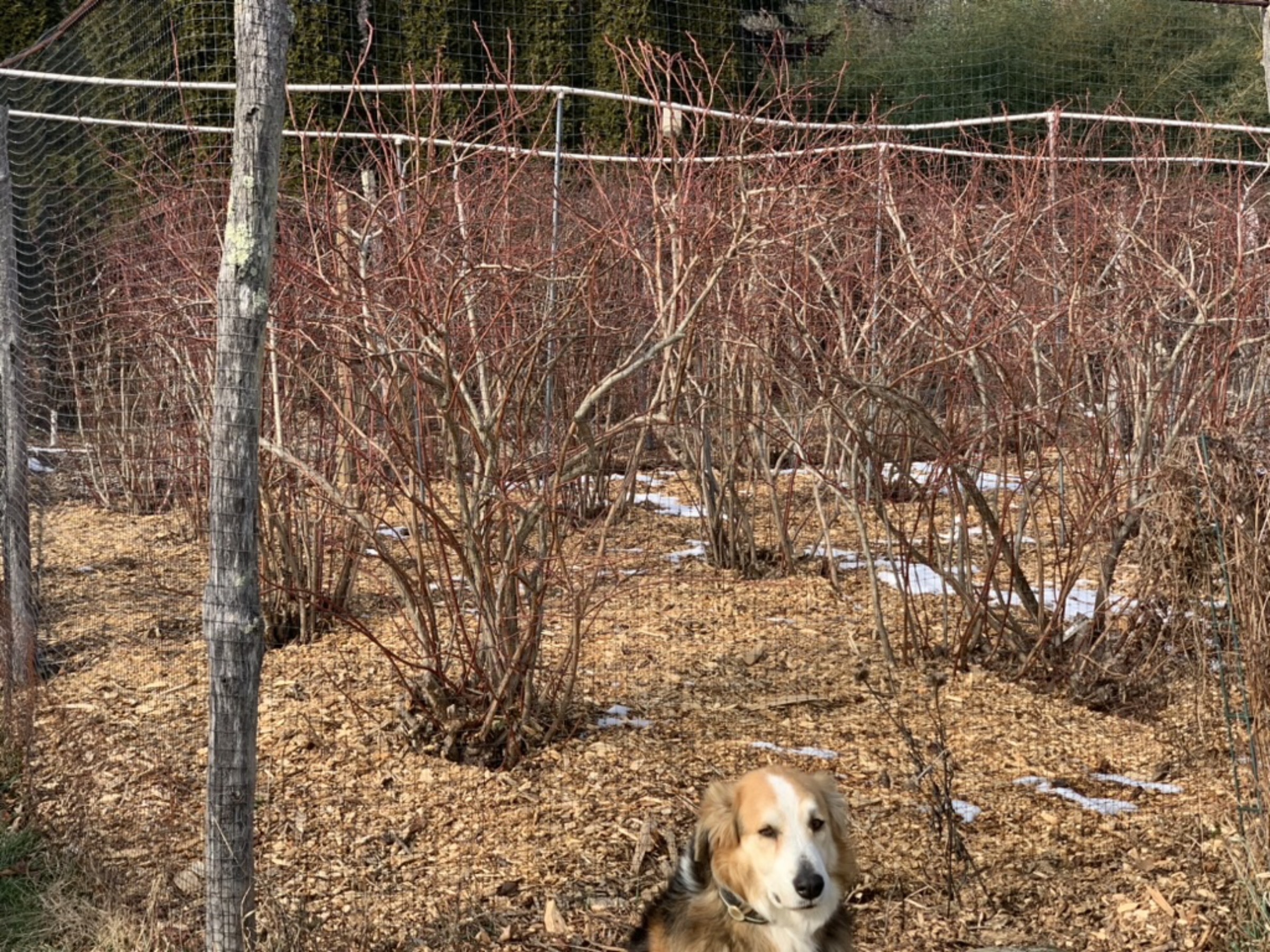
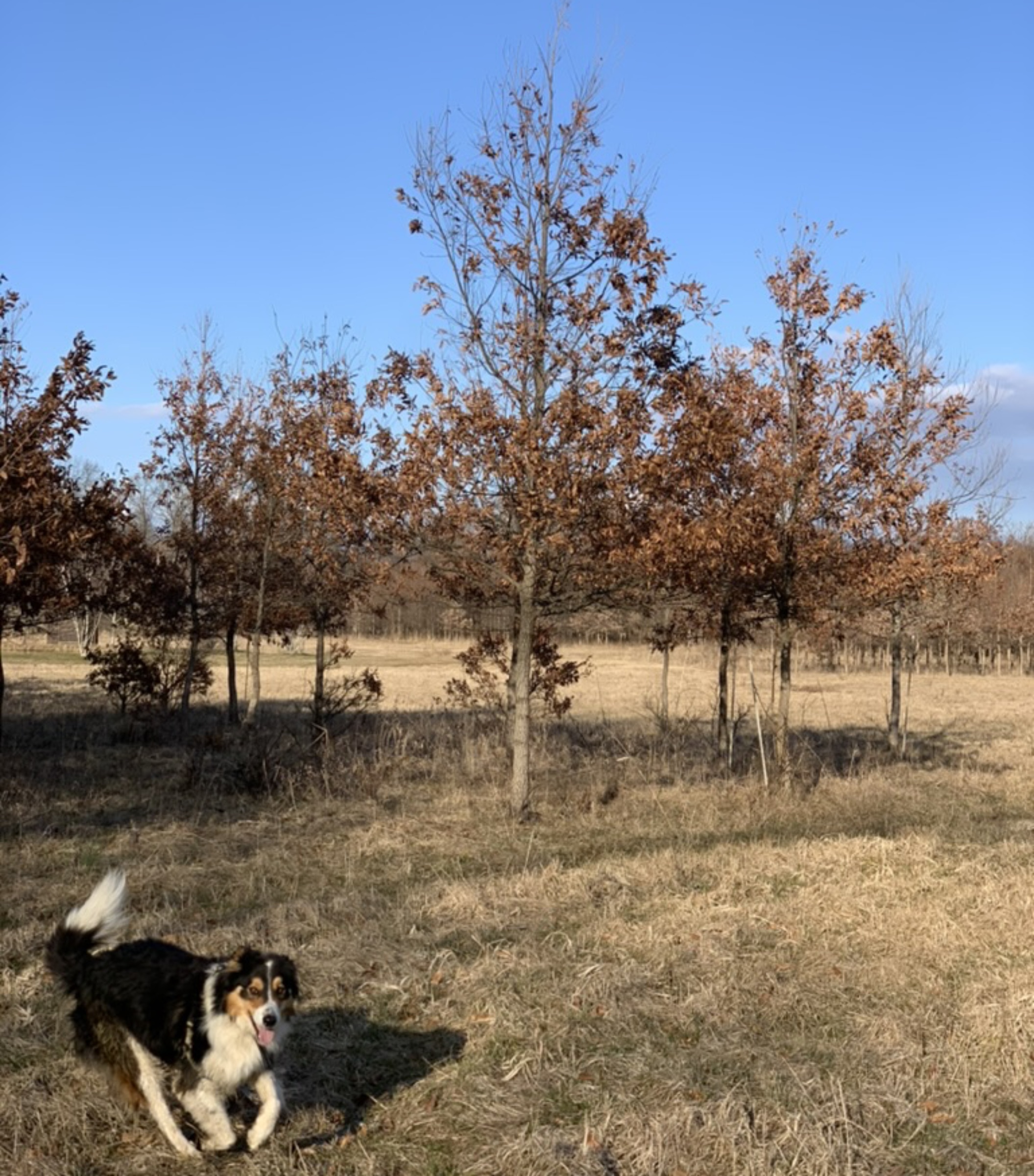
Love your blogs. Very informative and challenging me to try new techniques.
Thanks.
Wow, two fascinating experiments there. It never occurred to me that cardoon roots could overwinter in zone 5 with a bit of protection and I really love this fig method. I’ll be watching closely to see this develop with an eye toward giving this a try. Thank you.
Two years ago I tried cardoons from seed. It was pretty successful, although the deer did enjoy them while small so we had some set backs. I figured it was a “one year and done” experience, but two plants came up next the their mothers the following season. I’d done nothing to encourage them. However, I suspect as you said – the winter was “warm”, plus the site is on the south-face of a 10x10x6 ft boulder which would have protected it from northern and eastern winds. I am impressed with your “pot and chips” method, however, and thank you for the suggestion.
Depending on the amount of winter cold you get, chips alone might work.
This is genius and, indeed, looks a little simpler than all the other ways I’ve seen people over-wintering figs.
Oh, and . . . if you’re giving away those daughter cardoons, give me a holler. I’m in Millbrook.
I’ll see what the daughters look like when growth gets stronger.
Thanks!
You are giving me some ideas to try with some of my figs! Do you have any recommendations for an exceptionally hardy green fig variety? I envy you with your cardoon plant: if any of our plants are left unharvested at the end of a season, we lose them over the winter to voles.
I’m not so sure that there’s much variation in cold-hardiness from one fig variety to the next. Also very important is how soon the variety starts ripening its figs on new shoots.
As far as cardoons, voles aren’t so bad here, probably thanks to two outdoor dogs, one outdoor at, and 6 ducks (yes, I have seen my ducks catch and eat small rodents!).
Lee, how much snow do you get on the ground? Here in Spokane we had just over 2’ at the maximum in late December. Do you think your polycarbonate solution would work under those conditions? Thank you for an always fascinating and enlightening blog!
Yes, the “tents” would would great under snow. The triangular shape is strong and the snow would provide insulation. But my question is: Why protect the figs when Spokane winters hardly get below freezing. Figs tolerate winter lows into the ‘teens.
Lee where we live we got a few consecutive days below 10 degrees ( 6, 4) . We live east of downtown Spokane at about 2700 feet, so yeah—we get cold sometimes!
Ah. 7000 feet makes a big difference.
I really appreciate your work, especially the research part of it which made the whole point very easy to understand. After all, I’ll be subscribing to your feed and I am hoping you write again very soon.
How did the fig in the trench actually work out? Any updates? This will be year 2 of the new approach, yes?
Yes, year 2. Last year the late frost set everything back so there was nothing to report. I’m looking forward to the unveiling and growth this year, with the plants well established.